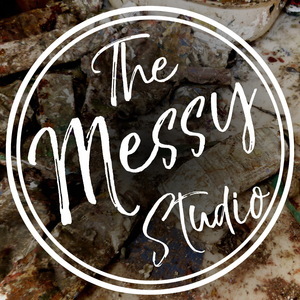Changing Directions
Episode 64 · March 23rd, 2019 · 25 mins 35 secs
About this Episode
The creative journey is never a straight path and all artists go through
times of change in their work. These are necessary but can also be frustrating and
painful as you head into the unknown. Today we’re going to talk about times of
change in your work and some of the challenges that artists face, including the
experiences of one Chicago painter who has shared her struggle with Rebecca.
http://www.joangearystudio.com/
www.rebeccacrowell.com
www.squeegeepress.com
www.facebook.com/messystudiopodcast
Notes:
“Nothing is constant but change”—good mantra for those of us in creative fields
Change is holistic—affects your work, and how you view it, your market, your
opportunities.
Relates to previous podcast about blocks, which can be related to resisting change
Necessity of change for growth, keeping ideas fresh, avoiding repetition and
boredom—as artists we recognize this need and yet may shy away out of concern
for other’s reactions—galleries, collectors, our own circle of family and friends
I see it in workshops—the urge to move into abstraction –takes time
Shows true dedication to the process
Stressful if you have commitments to exhibit in the midst of change—wanting to
show new work but not sure if you can pull it off in time. Go into some strategies
for this in next podcast
introduce Joan Geary who recently shared her struggles with change with me via
email. (Friend and former student in cold wax workshops who has been struggling
with change—desire to find a more personal voice and way of expressing her
ideas.)
Long interested in expressing light in her work but had not found her way in
technical terms. Issue of form and content—cold wax artists tend to work most
successfully with aspects of texture and numerous layers; many paintings tend to
have a very solid presence.
There are those whose work emanates light (JMS) but it’s important to find one’s
own way
Joan was challenged by a gallerist/friend to take her work to a new level. Felt like
criticism at first but J. also saw the need herself. Realized she was stuck in a mode
of trying produce work rather than keeping on exploring and growing. (Very
typical and easy trap to fall into with demands and pressures on us.)
Studied other painters such as Helen Frankenthaler and Emily Mason --ended up
developing a new technical approach in her cold wax work, involves pouring paint
onto the panel. Involved a LOT of trial and error, frustration, despair.
Technical issue of finding right consistency and additives to allow paint to adhere.
Chipping and flaking issues. Did research, tried a lot of things.
Worked on this for about 6 months before achieving any success. Will post the
painting that was successful as a result of efforts.
Impressive amount of focus and determination. All while under pressure with 3
exhibits on the horizon. Excellent example of what we talked about in the podcast
about being blocked.
We have to be open to change or stagnate. But as Joan said, growth is painful.
How to distinguish change from simply being too scattered, which is a concern for
many artists.
How do you know you are growing instead of spreading too thin
Look for connection
It can start out as random but sometimes random means intuitive—do you keep
on with the idea? Ask if it feels right for you, is there something truly intriguing?
Instructor once gave me a compliment -- he could see a logical connection from
one group of work to the next—showing exploration, moving step by step –done
intuitively, I was not aware of it. But seeing the connection was encouraging.
ask if it feels right and sincere to you, while allowing for a wide view of yourself
Try and see the purposeful reasons for change, it can help to define it –
Take your time, no rush to get feedback or show the new work
Sometimes you need to digest it alone for a while; resist urge to seek validation
from a lot of people right away. Social media validation is easy to come by and
can be too influential.
Talk to someone you trust or keep it around long enough to feel you trust it
yourself.
The time of creating new work/transitional time/you are vulnerable
Not to be afraid, just know that it may take some time to really understand what
you are doing.
The most significant changes take place somewhat slowly, organically. Can start
with bold moves but takes time to understand and integrate.
Realize it can change how you are viewed as an artist in positive ways.
In conclusion, change is integral to the creative process, welcome it, respect it,
give it time. Holisitc, affecting not only the work but how it is seen, by whom, how
others see your work
